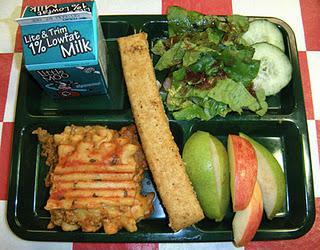Over the past two weeks, media coverage of America’s school lunches has – thankfully – gone from worse to wonderful. First, the pizza-as-veggie headlines erupted into ridiculousness after Congress voted on November 17th to make some changes in the proposed rule for new USDA school meal standards. For the record, “Congress did not declare pizza as a vegetable” (Washington Post). Tomato paste did become one more topic for partisan political bickering In DC, as outlined by the St. Petersburg Times Truth-o-Meter on November 22nd.
Fortunately, “lunch ladies” set the record straight for themselves with a primetime performance on the November 22nd episode of Food Network’s Chopped. As four school nutrition professionals sliced and diced their way to TV fame, America saw, firsthand, the creativity and commitment that go into preparing millions of healthful meals for hungry children every day. It’s no wonder that White House Policy Advisor for Healthy Food Initiatives, Chef Sam Kass, declared, ”These women are heroes.”
The good news for American kids is that these Chopped Class Acts contestants, led by top prize winner Cheryl Barbara from New Haven, Connecticut, represent thousands of unsung heroes in schools from coast to coast. Here are three of my favorite school districts, representing the real revolution in our school cafeterias – positive stories and photos showing Washington, DC, that America's "Lunch Ladies" are way ahead of you on pizza AND vegetables.
Just northeast of NewHaven, in Pawtucket, Rhode Island, Solange Morrisette is the General Manger of the foodservice management contract with the district (serving 9,000+ kids, 71% free/reduced) and Co-Chair of Rhode Island’s Healthy Schools Coalition. With ten HealthierUS School Challenge Awardwinning schools, Panini stations, and made-from-scratch sweet potato muffins, Pawtucket is dedicated to putting delicious nutrition – locally grown whenever possible – on school trays every day. Everything on this October fruit and veggie bar is Rhode Island grown except the grapes!As we head to the other coast, let’s make a stopover in Provo, Utah, where director Jenilee McComb oversees an award-winning Child Nutrition Program, serving 14,600+ students with about 45% eligible for free/reduced meals. The Provo Facebook page is a wonderful window into how local schools feed and support local communities, by buying from local farms and orchards, serving Thanksgiving family feasts, and celebrating Veterans’ Day with Heroes Lunch at school. Like many school districts, Provo has brought ideas from local chefs to school – and put some unexpected foods, like Quinoa and Black Bean Salad, on the menu. Where Interstate 84 nears the Pacific coast, 3,000+ miles from Rhode Island, the large, urban Portland, Oregon, Public School District serves 46,000+ students (45% free/reduced) in 88 schools with 240 foodservice staff. In this ethnically diverse city, the Nutrition Services Department, directed by Gitta Grether-Sweeney, MS, RD, has menu descriptions in 6 languages and serves 11,000 breakfasts, 21,000 lunches, and 2,000 suppers daily – with no a la carte sales. Portland purchases over 30% of its products from local vendors for Farm to School programs like Harvest of the Month and Local Flavors, illustrated on this eye-catching tray with made-from-scratch lasagna and whole grain breadstick, plus Oregon apples, pears, greens, pasta, and more. With a strong commitment to school gardens and nutrition education, Portland is a prime example of excellence in school nutrition.From sea to shining sea, three very different districts doing what’s right for kids’ nutrition every school day – and through the summer months as well. Breakfast, lunch, and sometimes supper, the everyday heroes in school cafeterias are helping our children to make smart choices for strong bodies and sharp brains. That’s what should make the headlines in DC – and every other American community.




